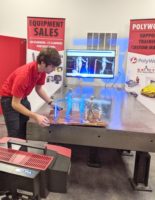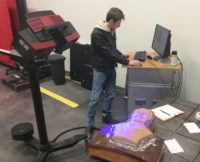Image Analysis Helps Develop Products
The power tools division of Black & Decker (Towson, MD) uses a turnkey image analysis system that it acquired about two years ago from Clemex Technologies Inc. (Longueuil, Quebec, Canada) for quality inspection and research and development. The high-end turnkey system consists of a computer, motorized stage, microscope, camera, printer and two monitors. One monitor is used to display a high-resolution image and the other is used to develop imaging routines.
The company uses the system for a variety of projects. Which is important because Black & Decker, a leader in the power tool industry, introduces new products regularly. Rich Williams, senior materials technician at Black & Decker says, "We work very closely with key product development teams, providing them with detailed image analysis reports in our evaluation of their prototypes."
Micro-structural evaluation
In performing micro-structural evaluation of samples, the metallurgical lab conducts a variety of tests that include the analysis of steel alloy and powder-metal gears, thickness checks of titanium and zinc plating, and carbide analysis.
For instance, the company used the system to inspect diamonds used in a diamond tile cutting blade. The system was used to separate them visually and measure their sizes. Different colors signify that the image has been processed and enable the user to ensure that individual objects have been separated by the software. Statistical data can then be extracted such as object size, area and count.
To perform these tests, a lab technician follows stringent procedures in preparing samples, which may include cutting, mounting and polishing before the actual analysis. Sample preparation is key in conducting accurate analysis work. Effective preparation of samples enables operators to visually reveal the material's structure. Following this step, the technician places the sample on the microscope and runs a predetermined imaging routine or develops a custom routine in order to quantify the image. Characteristics such as volume fractions, particle sizes, or other dimensions may be analyzed by object or field. The data and image is then presented in a report and submitted to product development teams for further prototyping.
Accurate results obtained fast
In addition to providing accurate results quickly, the image analysis system offers other advantages over traditional methods.
"Previous to using image analysis, our lab was spending money on film, which could be better spent elsewhere. With digital imaging, not only do we get better results, we can capture an unlimited number of images and not have to worry about film cost," says Williams.
Previously, the company would spend about $3,000 to $4,000 per year on film, but they took a limited number of images. With the new system, they take about 2,000 photos per year.
In addition, the results generated by the system are more accurate because the image analysis is more automated and that eliminates potential human error. For example, when conducting a grain-size analysis, human operators would evaluate the micro-structural composition of the sample as seen in the microscope with standard industry charts to gage for quality, a time-consuming and less-accurate method.
Williams adds, "Another important advantage of our system, is that we are able to better communicate with our colleagues with the use of the software's annotation tools. We'll typically snap some images and overlay our comments on the image using features such as text boxes, lines and ellipses in order to emphasize particular areas of the image."
The ability to share information via electronic means, as well as store records in an organized, compact manner is important to daily operations in the Materials Lab at Black & Decker, says Alan Paris, senior materials engineer for the company.
"Being a global company it is critical for us to be able to communicate in a timely manner with our colleagues around the world," Paris explains.
Clemex Technologies Inc.
(450) 651-6573.
www.clemex.com
BENEFITS.
With digital imaging, an unlimited number of images can be captured without the cost of film.
Technicians can run a pre-determined imaging routine or develop a custom routine to quantify the image.
Characteristics such as volume fractions, particle sizes, or other dimensions may be analyzed by object or field. The data and image is then presented in a report and submitted to product development teams for further prototyping.
The software allows images to be sent electronically to colleagues and customers in other offices.
Looking for a reprint of this article?
From high-res PDFs to custom plaques, order your copy today!





